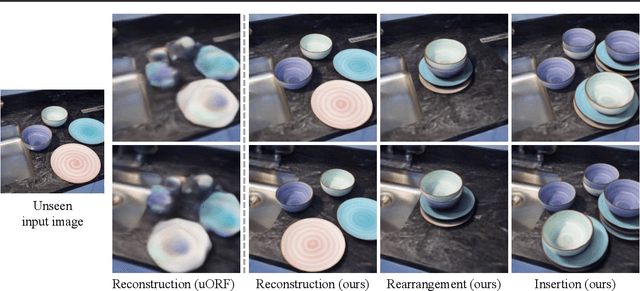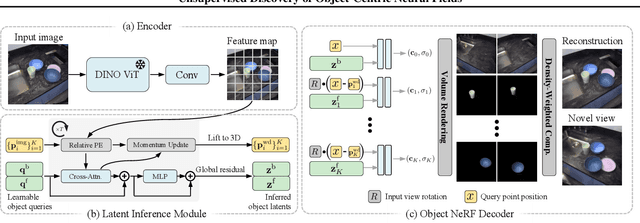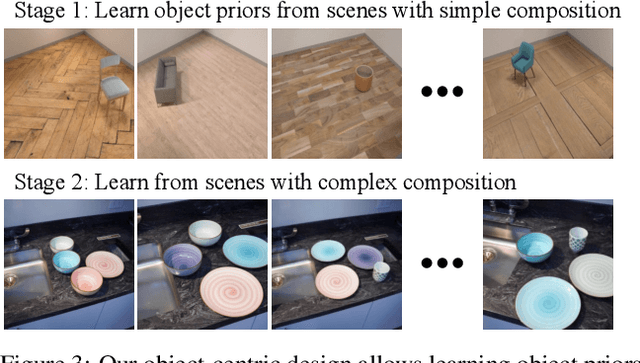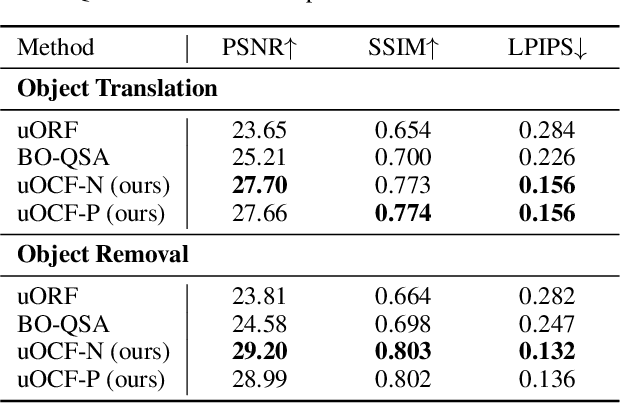Hong-Xing Yu
WonderPlay: Dynamic 3D Scene Generation from a Single Image and Actions
May 23, 2025Abstract:WonderPlay is a novel framework integrating physics simulation with video generation for generating action-conditioned dynamic 3D scenes from a single image. While prior works are restricted to rigid body or simple elastic dynamics, WonderPlay features a hybrid generative simulator to synthesize a wide range of 3D dynamics. The hybrid generative simulator first uses a physics solver to simulate coarse 3D dynamics, which subsequently conditions a video generator to produce a video with finer, more realistic motion. The generated video is then used to update the simulated dynamic 3D scene, closing the loop between the physics solver and the video generator. This approach enables intuitive user control to be combined with the accurate dynamics of physics-based simulators and the expressivity of diffusion-based video generators. Experimental results demonstrate that WonderPlay enables users to interact with various scenes of diverse content, including cloth, sand, snow, liquid, smoke, elastic, and rigid bodies -- all using a single image input. Code will be made public. Project website: https://kyleleey.github.io/WonderPlay/
Digital Twin Catalog: A Large-Scale Photorealistic 3D Object Digital Twin Dataset
Apr 11, 2025



Abstract:We introduce Digital Twin Catalog (DTC), a new large-scale photorealistic 3D object digital twin dataset. A digital twin of a 3D object is a highly detailed, virtually indistinguishable representation of a physical object, accurately capturing its shape, appearance, physical properties, and other attributes. Recent advances in neural-based 3D reconstruction and inverse rendering have significantly improved the quality of 3D object reconstruction. Despite these advancements, there remains a lack of a large-scale, digital twin quality real-world dataset and benchmark that can quantitatively assess and compare the performance of different reconstruction methods, as well as improve reconstruction quality through training or fine-tuning. Moreover, to democratize 3D digital twin creation, it is essential to integrate creation techniques with next-generation egocentric computing platforms, such as AR glasses. Currently, there is no dataset available to evaluate 3D object reconstruction using egocentric captured images. To address these gaps, the DTC dataset features 2,000 scanned digital twin-quality 3D objects, along with image sequences captured under different lighting conditions using DSLR cameras and egocentric AR glasses. This dataset establishes the first comprehensive real-world evaluation benchmark for 3D digital twin creation tasks, offering a robust foundation for comparing and improving existing reconstruction methods. The DTC dataset is already released at https://www.projectaria.com/datasets/dtc/ and we will also make the baseline evaluations open-source.
WorldScore: A Unified Evaluation Benchmark for World Generation
Apr 01, 2025Abstract:We introduce the WorldScore benchmark, the first unified benchmark for world generation. We decompose world generation into a sequence of next-scene generation tasks with explicit camera trajectory-based layout specifications, enabling unified evaluation of diverse approaches from 3D and 4D scene generation to video generation models. The WorldScore benchmark encompasses a curated dataset of 3,000 test examples that span diverse worlds: static and dynamic, indoor and outdoor, photorealistic and stylized. The WorldScore metrics evaluate generated worlds through three key aspects: controllability, quality, and dynamics. Through extensive evaluation of 19 representative models, including both open-source and closed-source ones, we reveal key insights and challenges for each category of models. Our dataset, evaluation code, and leaderboard can be found at https://haoyi-duan.github.io/WorldScore/
FluidNexus: 3D Fluid Reconstruction and Prediction from a Single Video
Mar 06, 2025Abstract:We study reconstructing and predicting 3D fluid appearance and velocity from a single video. Current methods require multi-view videos for fluid reconstruction. We present FluidNexus, a novel framework that bridges video generation and physics simulation to tackle this task. Our key insight is to synthesize multiple novel-view videos as references for reconstruction. FluidNexus consists of two key components: (1) a novel-view video synthesizer that combines frame-wise view synthesis with video diffusion refinement for generating realistic videos, and (2) a physics-integrated particle representation coupling differentiable simulation and rendering to simultaneously facilitate 3D fluid reconstruction and prediction. To evaluate our approach, we collect two new real-world fluid datasets featuring textured backgrounds and object interactions. Our method enables dynamic novel view synthesis, future prediction, and interaction simulation from a single fluid video. Project website: https://yuegao.me/FluidNexus.
ZeroHSI: Zero-Shot 4D Human-Scene Interaction by Video Generation
Dec 24, 2024Abstract:Human-scene interaction (HSI) generation is crucial for applications in embodied AI, virtual reality, and robotics. While existing methods can synthesize realistic human motions in 3D scenes and generate plausible human-object interactions, they heavily rely on datasets containing paired 3D scene and motion capture data, which are expensive and time-consuming to collect across diverse environments and interactions. We present ZeroHSI, a novel approach that enables zero-shot 4D human-scene interaction synthesis by integrating video generation and neural human rendering. Our key insight is to leverage the rich motion priors learned by state-of-the-art video generation models, which have been trained on vast amounts of natural human movements and interactions, and use differentiable rendering to reconstruct human-scene interactions. ZeroHSI can synthesize realistic human motions in both static scenes and environments with dynamic objects, without requiring any ground-truth motion data. We evaluate ZeroHSI on a curated dataset of different types of various indoor and outdoor scenes with different interaction prompts, demonstrating its ability to generate diverse and contextually appropriate human-scene interactions.
WonderWorld: Interactive 3D Scene Generation from a Single Image
Jun 14, 2024Abstract:We present WonderWorld, a novel framework for interactive 3D scene extrapolation that enables users to explore and shape virtual environments based on a single input image and user-specified text. While significant improvements have been made to the visual quality of scene generation, existing methods are run offline, taking tens of minutes to hours to generate a scene. By leveraging Fast Gaussian Surfels and a guided diffusion-based depth estimation method, WonderWorld generates geometrically consistent extrapolation while significantly reducing computational time. Our framework generates connected and diverse 3D scenes in less than 10 seconds on a single A6000 GPU, enabling real-time user interaction and exploration. We demonstrate the potential of WonderWorld for applications in virtual reality, gaming, and creative design, where users can quickly generate and navigate immersive, potentially infinite virtual worlds from a single image. Our approach represents a significant advancement in interactive 3D scene generation, opening up new possibilities for user-driven content creation and exploration in virtual environments. We will release full code and software for reproducibility. Project website: https://WonderWorld-2024.github.io/
BEHAVIOR Vision Suite: Customizable Dataset Generation via Simulation
May 15, 2024



Abstract:The systematic evaluation and understanding of computer vision models under varying conditions require large amounts of data with comprehensive and customized labels, which real-world vision datasets rarely satisfy. While current synthetic data generators offer a promising alternative, particularly for embodied AI tasks, they often fall short for computer vision tasks due to low asset and rendering quality, limited diversity, and unrealistic physical properties. We introduce the BEHAVIOR Vision Suite (BVS), a set of tools and assets to generate fully customized synthetic data for systematic evaluation of computer vision models, based on the newly developed embodied AI benchmark, BEHAVIOR-1K. BVS supports a large number of adjustable parameters at the scene level (e.g., lighting, object placement), the object level (e.g., joint configuration, attributes such as "filled" and "folded"), and the camera level (e.g., field of view, focal length). Researchers can arbitrarily vary these parameters during data generation to perform controlled experiments. We showcase three example application scenarios: systematically evaluating the robustness of models across different continuous axes of domain shift, evaluating scene understanding models on the same set of images, and training and evaluating simulation-to-real transfer for a novel vision task: unary and binary state prediction. Project website: https://behavior-vision-suite.github.io/
PhysDreamer: Physics-Based Interaction with 3D Objects via Video Generation
Apr 19, 2024Abstract:Realistic object interactions are crucial for creating immersive virtual experiences, yet synthesizing realistic 3D object dynamics in response to novel interactions remains a significant challenge. Unlike unconditional or text-conditioned dynamics generation, action-conditioned dynamics requires perceiving the physical material properties of objects and grounding the 3D motion prediction on these properties, such as object stiffness. However, estimating physical material properties is an open problem due to the lack of material ground-truth data, as measuring these properties for real objects is highly difficult. We present PhysDreamer, a physics-based approach that endows static 3D objects with interactive dynamics by leveraging the object dynamics priors learned by video generation models. By distilling these priors, PhysDreamer enables the synthesis of realistic object responses to novel interactions, such as external forces or agent manipulations. We demonstrate our approach on diverse examples of elastic objects and evaluate the realism of the synthesized interactions through a user study. PhysDreamer takes a step towards more engaging and realistic virtual experiences by enabling static 3D objects to dynamically respond to interactive stimuli in a physically plausible manner. See our project page at https://physdreamer.github.io/.
Reconstruction and Simulation of Elastic Objects with Spring-Mass 3D Gaussians
Mar 14, 2024Abstract:Reconstructing and simulating elastic objects from visual observations is crucial for applications in computer vision and robotics. Existing methods, such as 3D Gaussians, provide modeling for 3D appearance and geometry but lack the ability to simulate physical properties or optimize parameters for heterogeneous objects. We propose Spring-Gaus, a novel framework that integrates 3D Gaussians with physics-based simulation for reconstructing and simulating elastic objects from multi-view videos. Our method utilizes a 3D Spring-Mass model, enabling the optimization of physical parameters at the individual point level while decoupling the learning of physics and appearance. This approach achieves great sample efficiency, enhances generalization, and reduces sensitivity to the distribution of simulation particles. We evaluate Spring-Gaus on both synthetic and real-world datasets, demonstrating accurate reconstruction and simulation of elastic objects. This includes future prediction and simulation under varying initial states and environmental parameters. Project page: https://zlicheng.com/spring_gaus.
Unsupervised Discovery of Object-Centric Neural Fields
Feb 12, 2024



Abstract:We study inferring 3D object-centric scene representations from a single image. While recent methods have shown potential in unsupervised 3D object discovery from simple synthetic images, they fail to generalize to real-world scenes with visually rich and diverse objects. This limitation stems from their object representations, which entangle objects' intrinsic attributes like shape and appearance with extrinsic, viewer-centric properties such as their 3D location. To address this bottleneck, we propose Unsupervised discovery of Object-Centric neural Fields (uOCF). uOCF focuses on learning the intrinsics of objects and models the extrinsics separately. Our approach significantly improves systematic generalization, thus enabling unsupervised learning of high-fidelity object-centric scene representations from sparse real-world images. To evaluate our approach, we collect three new datasets, including two real kitchen environments. Extensive experiments show that uOCF enables unsupervised discovery of visually rich objects from a single real image, allowing applications such as 3D object segmentation and scene manipulation. Notably, uOCF demonstrates zero-shot generalization to unseen objects from a single real image. Project page: https://red-fairy.github.io/uOCF/
 Add to Chrome
Add to Chrome Add to Firefox
Add to Firefox Add to Edge
Add to Edge